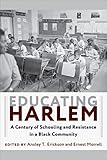Educating Harlem : A Century of Schooling and Resistance in a Black Community / ed. by Ansley T. Erickson, Ernest Morrell.
Material type: TextPublisher: New York, NY : Columbia University Press, [2019]Copyright date: ©2019Description: 1 online resource : 9 illustrationsContent type:
TextPublisher: New York, NY : Columbia University Press, [2019]Copyright date: ©2019Description: 1 online resource : 9 illustrationsContent type: - 9780231182201
- 9780231544047
- African Americans -- Education -- New York (State) -- New York -- History -- 20th century
- African Americans -- Social conditions -- 20th century
- African Americans-Education-New York (State)-New York-History-20th century
- African Americans-Social conditions-20th century
- Discrimination in education -- New York (State) -- New York -- History -- 20th century
- Discrimination in education-New York (State)-New York-History-20th century
- Racism in education -- New York (State) -- New York -- History -- 20th century
- Racism in education-New York (State)-New York-History-20th century
- School improvement programs -- New York (State) -- New York
- School improvement programs-New York (State)-New York
- HISTORY / United States / 20th Century
- LC2803.N5
- online - DeGruyter
- Issued also in print.
| Item type | Current library | Call number | URL | Status | Notes | Barcode | |
|---|---|---|---|---|---|---|---|
 eBook
eBook
|
Biblioteca "Angelicum" Pont. Univ. S.Tommaso d'Aquino Nuvola online | online - DeGruyter (Browse shelf(Opens below)) | Online access | Not for loan (Accesso limitato) | Accesso per gli utenti autorizzati / Access for authorized users | (dgr)9780231544047 |
Frontmatter -- Contents -- Acknowledgments -- Abbreviations -- Introduction -- PART ONE. Debating What and How Harlem Students Learn in the Renaissance and Beyond -- 1. Schooling the New Negro: Progressive Education, Black Modernity, and the Long Harlem Renaissance -- 2. "A Serious Pedagogical Situation": Diverging School Reform Priorities in Depression- Era Harlem -- 3. Wadleigh High School: The Price of Segregation -- PART TWO. Organizing, Writing, and Teaching for Reform in the 1930s Through the 1950s -- 4. Cinema for Social Change: The Human Relations Film Series of the Harlem Committee of the Teachers Union, 1936-1950 -- 5. Bringing Harlem to the Schools: Langston Hughes's The First Book of Negroes and Crafting a Juvenile Readership -- 6. Harlem Schools and the New York City Teachers Union -- PART THREE. Divergent Educational Visions in the Activist 1960s and 1970s -- 7. HARYOU: An Apprenticeship for Young Leaders -- 8. Intermediate School 201: Race, Space, and Modern Architecture in Harlem -- 9. Black Power as Educational Renaissance: The Harlem Landscape -- 10. "Harlem Sophistication": Community- Based Paraprofessional Educators in Central Harlem and East Harlem -- PART FOUR. Post- Civil Rights Setbacks and Structural Alternatives -- 11. Harlem Schools in the Fiscal Crisis -- 12. Pursuing "Real Power to Parents": Babette Edwards's Activism from Community Control to Charter Schools -- 13. Teaching Harlem: Black Teachers and the Changing Educational Landscape of Twenty- First-Century Central Harlem -- Conclusion -- Contributors -- Index
restricted access online access with authorization star
http://purl.org/coar/access_right/c_16ec
Over the course of the twentieth century, education was a key site for envisioning opportunities for African Americans, but the very schools they attended sometimes acted as obstacles to black flourishing. Educating Harlem brings together a multidisciplinary group of scholars to provide a broad consideration of the history of schooling in perhaps the nation's most iconic black community.The volume traces the varied ways that Harlem residents defined and pursued educational justice for their children and community despite consistent neglect and structural oppression. Contributors investigate the individuals, organizations, and initiatives that fostered educational visions, underscoring their breadth, variety, and persistence. Their essays span the century, from the Great Migration and the Harlem Renaissance through the 1970s fiscal crisis and up to the present. They tell the stories of Harlem residents from a wide variety of social positions and life experiences, from young children to expert researchers to neighborhood mothers and ambitious institution builders who imagined a dynamic array of possibilities from modest improvements to radical reshaping of their schools. Representing many disciplinary perspectives, the chapters examine a range of topics including architecture, literature, film, youth and adult organizing, employment, and city politics. Challenging the conventional rise-and-fall narratives found in many urban histories, the book tells a story of persistent struggle in each phase of the twentieth century. Educating Harlem paints a nuanced portrait of education in a storied community and brings much-needed historical context to one of the most embattled educational spaces today.
Issued also in print.
Mode of access: Internet via World Wide Web.
In English.
Description based on online resource; title from PDF title page (publisher's Web site, viewed 02. Mrz 2022)


